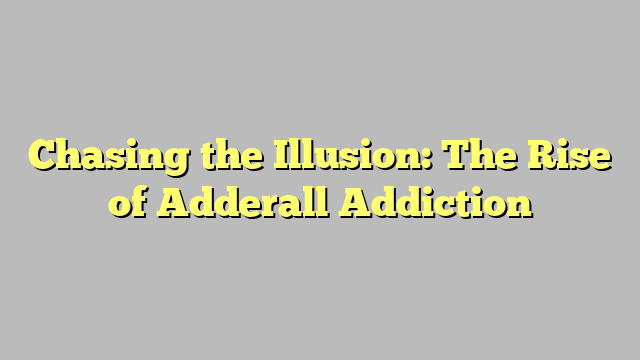In today’s fast-paced and demanding world, the pressure to excel and stay focused is stronger than ever. For many individuals, the lure of a pill that promises increased concentration and energy can be tempting. Adderall, a prescription stimulant primarily used for treating attention-deficit hyperactivity disorder (ADHD), has increasingly found its way into the hands of individuals seeking a competitive edge or a quick fix for their productivity challenges. However, what may start as a seemingly harmless solution to help meet academic or work demands can quickly spiral into a dangerous cycle of dependence and addiction. The rise of Adderall addiction is a growing concern, with many individuals finding themselves trapped in a cycle of misuse and dependency that can have devastating consequences.
The Adderall Epidemic
The rise of Adderall addiction has become a pressing concern in recent years, particularly among young adults and college students. The allure of this stimulant medication, commonly prescribed for ADHD, has led to its widespread misuse as a study aid and performance enhancer.
The easy availability of Adderall through illicit channels further contributes to the growing epidemic of addiction. Many individuals obtain the drug without a prescription, unaware of the serious consequences of its misuse. The pressure to excel academically and socially fuels the cycle of dependency on Adderall.
Despite the potential health risks and legal implications, the use of Adderall continues to escalate, perpetuating the cycle of addiction. As cases of substance use disorder linked to Adderall rise, it is clear that a comprehensive approach is needed to address this troubling trend.
Recognizing the Signs
Signs of Adderall addiction can manifest in various ways, impacting both physical and mental well-being. One common indicator is the development of tolerance, where individuals require increasing doses to achieve the desired effects. This can lead to a dangerous cycle of escalating use, as the body becomes dependent on the drug to function normally.
Behavioral changes may also signal a problem with Adderall addiction. Persons struggling with this issue may exhibit secretive or deceitful behavior to obtain and use the drug. Social withdrawal, neglect of responsibilities, and a preoccupation with obtaining more Adderall are also red flags. These signs often indicate a deepening reliance on the drug to cope with daily life.
Physical symptoms of Adderall addiction can include insomnia, weight loss, rapid heart rate, and increased blood pressure. Additionally, individuals may experience mood swings, irritability, and anxiety when not using the drug. Recognizing these physical manifestations is crucial in identifying an Adderall addiction and seeking appropriate help and support.
Seeking Help and Treatment
It is crucial for individuals struggling with Adderall addiction to reach out for help as soon as possible. Seeking support from professionals such as doctors, therapists, or addiction counselors can provide the necessary guidance and resources to begin the recovery journey.
Treatment options for Adderall addiction may include therapy sessions to address underlying issues, detox programs to safely manage withdrawal symptoms, and support groups for ongoing encouragement and motivation. It’s essential to work closely with healthcare providers to create a personalized treatment plan that suits individual needs and circumstances.
Remember, recovery from Adderall addiction is a gradual process that requires dedication and perseverance. By taking the first step to seek help, individuals can start reclaiming their lives and moving towards a healthier, substance-free future.
